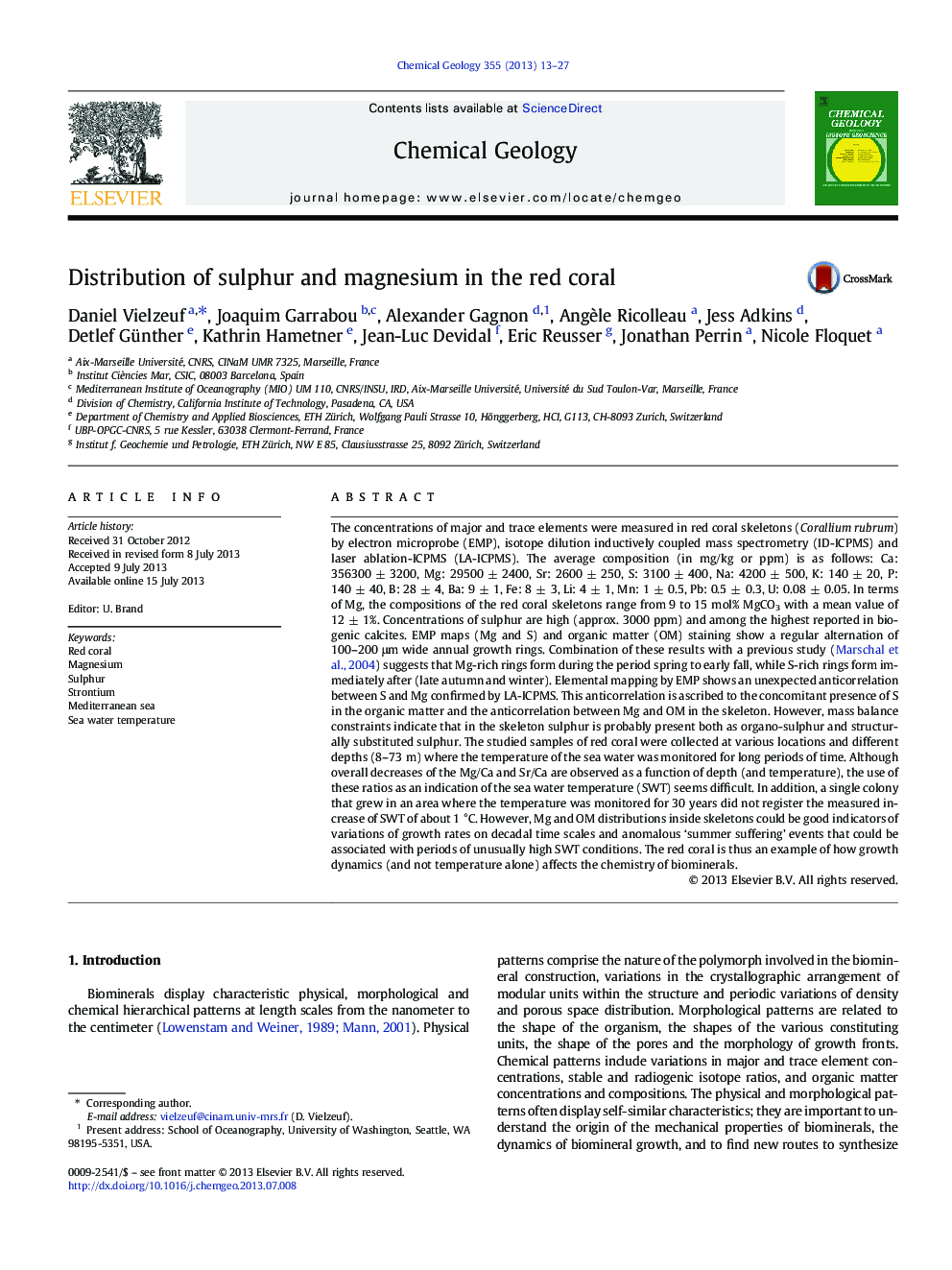| کد مقاله | کد نشریه | سال انتشار | مقاله انگلیسی | نسخه تمام متن |
|---|---|---|---|---|
| 6436787 | 1637614 | 2013 | 15 صفحه PDF | دانلود رایگان |
- Major and trace element concentrations have been determined in red coral skeletons.
- Large elemental internal variability is related to annual growth rings.
- Sulphur is present in both the organic matrix and the Mg-calcite.
- Mg/Ca and Sr/Ca ratios are not straightforward proxies of sea water temperature.
- Mg/Ca ratios record changing growth rates on decadal time scales.
The concentrations of major and trace elements were measured in red coral skeletons (Corallium rubrum) by electron microprobe (EMP), isotope dilution inductively coupled mass spectrometry (ID-ICPMS) and laser ablation-ICPMS (LA-ICPMS). The average composition (in mg/kg or ppm) is as follows: Ca: 356300 ± 3200, Mg: 29500 ± 2400, Sr: 2600 ± 250, S: 3100 ± 400, Na: 4200 ± 500, K: 140 ± 20, P: 140 ± 40, B: 28 ± 4, Ba: 9 ± 1, Fe: 8 ± 3, Li: 4 ± 1, Mn: 1 ± 0.5, Pb: 0.5 ± 0.3, U: 0.08 ± 0.05. In terms of Mg, the compositions of the red coral skeletons range from 9 to 15 mol% MgCO3 with a mean value of 12 ± 1%. Concentrations of sulphur are high (approx. 3000 ppm) and among the highest reported in biogenic calcites. EMP maps (Mg and S) and organic matter (OM) staining show a regular alternation of 100-200 μm wide annual growth rings. Combination of these results with a previous study (Marschal et al., 2004) suggests that Mg-rich rings form during the period spring to early fall, while S-rich rings form immediately after (late autumn and winter). Elemental mapping by EMP shows an unexpected anticorrelation between S and Mg confirmed by LA-ICPMS. This anticorrelation is ascribed to the concomitant presence of S in the organic matter and the anticorrelation between Mg and OM in the skeleton. However, mass balance constraints indicate that in the skeleton sulphur is probably present both as organo-sulphur and structurally substituted sulphur. The studied samples of red coral were collected at various locations and different depths (8-73 m) where the temperature of the sea water was monitored for long periods of time. Although overall decreases of the Mg/Ca and Sr/Ca are observed as a function of depth (and temperature), the use of these ratios as an indication of the sea water temperature (SWT) seems difficult. In addition, a single colony that grew in an area where the temperature was monitored for 30 years did not register the measured increase of SWT of about 1 °C. However, Mg and OM distributions inside skeletons could be good indicators of variations of growth rates on decadal time scales and anomalous 'summer suffering' events that could be associated with periods of unusually high SWT conditions. The red coral is thus an example of how growth dynamics (and not temperature alone) affects the chemistry of biominerals.
Journal: Chemical Geology - Volume 355, 26 September 2013, Pages 13-27
